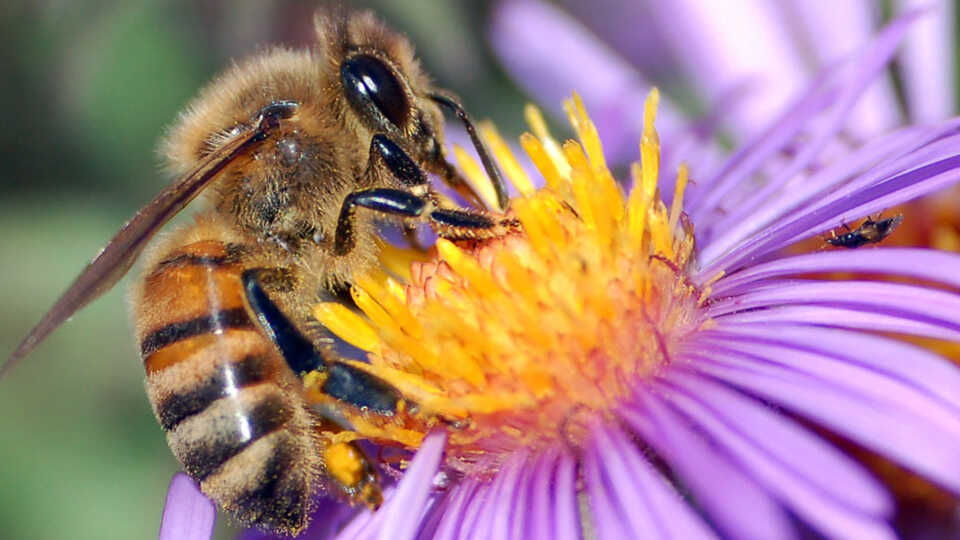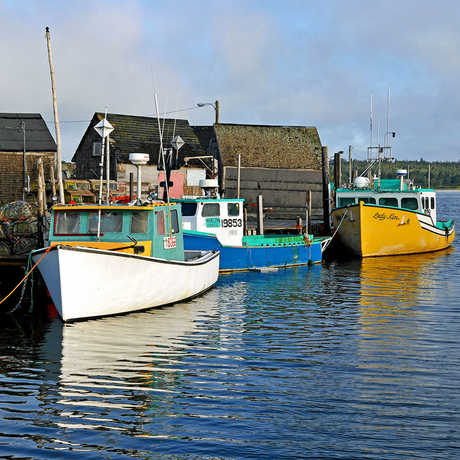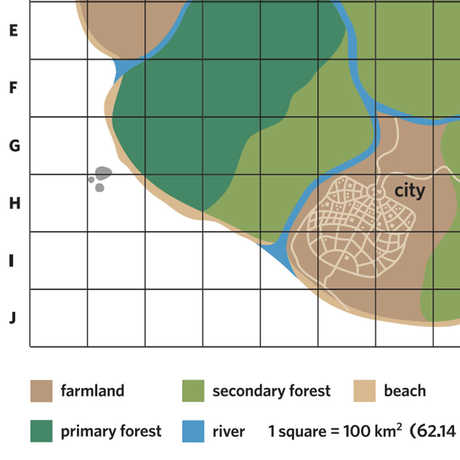
"European honey bee extracts nectar" by John Severns
In this activity, students learn about plant reproduction and use real data to construct explanations about which flowers are the most attractive to different pollinators.
In this lesson, students will:
- learn that flowers are adapted to attract specific pollinators.
- practice constructing explanations grounded in scientific data.
- learn that many plants depend on animals for pollination and many pollinators depend on plants for food.
- Flower Diagram (1 or 2 per group)
- Pollinator Profile cards (1 or 2 sets for class)
- Pollinator Data sheet (1 per student)
- Constructing Explanations sheet (1 per student)
- Imaginary Garden cards (optional – 1 or 2 sets for class)
- Imaginary Garden answer key (optional - 1 for teacher)
- Imaginary Garden flower tags (optional – 1 or 2 sets for class)
- Real flowers (optional, but we recommend lilies, irises, daffodils, tulips, gladiolas, poppies, or other large flowers with distinguishable parts)
- adaptation: a living organism’s physical/behavioral features that aid it in surviving within a specific habitat.
- angiosperm: flowering plants (pines, ferns, and mosses are not angiosperms)
- flower: the reproductive structure found in flowering plants (angiosperms).
- nectar: a sweet liquid secreted by flowers as an attractant and reward for pollinators.
- pollen: a powder-like substance in a flower (or cone) that is made up of grains. Each grain functions as a capsule for carrying the male gametes (sperm cells) of the plant.
- pollination: a necessary step in the reproduction of flowering plants; the process by which pollen is transferred from the male stamen to the female stigma, thereby enabling fertilization and sexual reproduction.
- pollinator: an animal (e.g. insect, bat) that involuntarily transfers a flower’s pollen from male reproductive organs to female reproductive organs.
- stigma: the pollen-receiving tip of a flower’s pistil (female part).
- stamen: the pollen-producing reproductive organ of a flower (male part).
- Print the following handouts:
- Pollinator Data Sheet (1 per student)
- Constructing Explanations sheet (1 per student)
- Flower Diagram (1 or 2 per group)
- Pollinator Profile cards (1 or 2 sets for the class – single-sided and on cardstock if possible)
- Create an Imaginary Garden for the students. This will be used in Part Three. There are numerous ways to do this, and here are two suggestions:
- Use the Imaginary Garden pdf included with this lesson. Follow these instructions:
- Print the Imaginary Garden cards single-sided, and on cardstock if possible.
- Cut each sheet down the middle length-wise to make a long card.
- Fold each card in half so the flower is on the front and the non-observable traits are on the back. Glue it shut.
- Teacher tip: Create 2 sets of Imaginary Garden flowers. This will make it more challenging in Part Three for students to find their flower because they won’t be able to use deductive reasoning.
- Create flowers with craft material like tissue paper and pipecleaners. Although this is more time consuming, having students look for the specific traits on non-real flowers will be more challenging, plus it will force them to think outside of their prior knowledge. This will also make the trick flowers actual trick flowers, whereas the ones in the pdf are real organisms with fake information. Your will need to create the following flowers:
- Blue or purple flower (butterfly)
- Red or orange flower (bird)
- A bunch of small, white, tube-shaped flowers (moth)
- A large white flower (fly)
- A flower of any color (bee)
- Large, white, cone-shaped flower (bat)
- 2 flowers of any shape and color (trick flowers)
- For each flower, attach the appropriate Flower Tag with its unobservable traits. Teacher tip: Create 2 sets of Imaginary Garden flowers. This will make it more challenging in Part Three for students to find their flower because they won’t be able to use deductive reasoning.
- Use the Imaginary Garden pdf included with this lesson. Follow these instructions:
- Arrange students into 6 groups.
- Ask students questions such as: “What are your favorite flowers?” “Why do plants have flowers?” “Are plants trying to win a beauty contest?” Flowers are for reproduction - flowers have their traits to attract pollinators. “Do you think all flowers are trying to attract the same pollinators?” “Why are there so many different types of flowers?” Different flowers attract different pollinators.
- Hand out 1 or 2 Flower Diagrams per group. Flowers have both male and female parts. Pollination is achieved when the pollen from the male part, the stamen, is transferred to the female part, the stigma. This can happen between the male and female parts of one flower (self-pollination) or between separate flowers of the same species (cross-pollination). Flowers can’t do it themselves. What in the natural world can help move the pollen? Animals, wind, or water!
- Pass out flowers for students to investigate. Have them peel the petals back to look for the different parts. Can they find all of the parts on the Flower Diagram? Teacher tip: Skip this step if you have students prone to pollen allergies!
- Pass out flowers for students to investigate. Have them peel the petals back to look for the different parts. Can they find all of the parts on the Flower Diagram? Teacher tip: Skip this step if you have students prone to pollen allergies!
- Why do pollinators (e.g. birds, insects, bats) visit flowers? Most feed on the nectar of a flower. The nectaries are usually located deep in the middle of a flower so that pollinators have to first brush against the anthers, and then the stigma to get to the nectar. Some pollinators, like bees, need pollen in addition to nectar. Some pollinating insects (e.g. some flies) are attracted to flowers by scent but gain no reward when they visit. The insects try to leave quickly but the flowers may have traps to slow the insects down.
- It may be useful to ask a few students to role-play the pollination process. You may also ask students to “hand-pollinate” the real flowers.
- Assign each group a pollinator: bee, bat, bird, butterfly, moth, or fly. They can pick a name out of a hat or you can assign them.
- Pass out the Pollinator Observation Data Sheets (1 per student). Students should take time to read the descriptions of all the flowers and look at the data before answering the questions. On the back, they will answer the following questions:
- Who is your pollinator?
- What number flower did your pollinator visit the most?
- What are 3 flower traits that you think attract your pollinator?
Let students know that they are beginning to construct explanations about what flower features attract their pollinator. Their explanations right now are only based on observations in the field, which is exactly how research scientists build their explanations. In the next step, they will receive more information about their pollinator to modify or strength their explanations.
- Pass out the Constructing Explanations sheets (1 per student) and the Pollinator Profile cards. Each group should get the Pollinator Profile that corresponds to their pollinator. Teacher tip: Depending on the size of your class, it may be helpful to have more than one set so it’s easier to share.
- Once students have read their Pollinator Profile, they will write down 3 flower traits that are attractive to their pollinator on the Constructing Explanations sheet. This time, they will have more information to use, so remind students to consider the following:
- Compare the information in the profile to the data gathered from pollinator observations. This can indicate if it’s a trait that the pollinator is attracted to, or is a trait the flower has for a different reason.
- Encourage students to not just look at the data from the flower their pollinator visited the most, but look at trends amongst all the flowers. For example, bees went to Flower 2 the most, but they also went to Flower 6 – do Flowers 2 and 6 have anything in common?
- These may end up being the same 3 traits that they wrote down earlier, but they need to be supported by the information they just learned about their pollinator.
- Set up your Imaginary Garden. Teacher tip: Set up your garden while students are working on Part Two, or do Parts One and Two before recess, and set up your garden while students are outside. Use a large table or area on the ground so the flowers may be spread out.
- Have the students come gather around the garden. Tell them that their job is to find one flower that that their pollinator would be most attracted to, based on their observation data and the information in their Pollinator Profile. It is important that they look not only at the flower itself, but the unobservable traits (smell, when it blooms, etc.) on the tag or back of the card. Remind students that in nature, flowers do not have tags explaining when they bloom or what they smell like. Botanists would have to go study the flowers, sometimes at night.
- Each group should work together to select one flower that their pollinator would be attracted to. Once they have selected their flower, they will take it back to their table.
- On their Constructing Explanations sheet, they will circle which flower they chose and write one sentence describing why that flower would attract their pollinator.
- Have students present their flowers to the class and explain why it would be attractive to their pollinator.
- Highlight that these evolutionary changes do not happen overnight. It takes hundreds or thousands of years for these adaptations to take shape. Ask students what they think would happen to their flower if their pollinator disappeared. Would it survive? If it did, how would it change?
- As a final discussion question, ask students how the pollinators may be adapted to the flowers. This can also be turned into a larger lesson or homework assignment, if desired (see Extensions).
- You may choose to extend this lesson and delve more deeply into flower anatomy at the beginning with a more formalized flower dissection.
- Take a field trip to a flower garden. Record your observations on what pollinators you see there. Be sure to include notes about the flowers themselves. Did you find anything surprising?
- To add an arts aspect, have each student create a flower with craft materials that would be attractive to their pollinator. This works especially well as an extension if the Imaginary Garden cards were used. Have each student write a few sentences about why this flower attracts their pollinator, and create a pollinator bouquet with the whole class.
- If students are advanced, you can extend the lesson through an exploration of co-evolution. Challenge students to research pollinators and find out the ways in which the pollinators themselves are adapted to certain flowers.
- A fabulous example of this to share with students is the Darwin’s hawk moth. You can read more about it here.
The Angiosperm Lifecycle
For angiosperms, or flowering plants, to reproduce, they go through pollination, create fruits, and disperse seeds. For the students, it is useful to describe the process in four steps: flower, pollination, fruit, and seed dispersal. In some cases, plants do not need animals for pollination or seed dispersal. In other cases, plants rely on animals for both processes and must attract each animal in a different way.
- Pollination: Pollination is the transfer of pollen from the stamens to the stigma of flowers. Pollen can be carried by insects, other animals, wind, or water. Self-pollination refers to the process in which pollen lands on the stigma of its own flower or another flower on the same plant. Cross-pollination refers to the process where pollen is transferred to the stigma of a flower on another plant of the same species.
Since ovules within the same plant can differ genetically from one another, self-pollination can result in some variation in the offspring. Cross-pollination, in which genetic material comes from two parents, results in greater variation and is therefore considered advantageous.
- Fertilization: Once the pollen grain reaches a compatible stigma, it receives a chemical signal from the stigma. The pollen then produces a tube, which grows down through the style, into the ovary, and into one of the ovules. This allows the male pollen cell to fuse with the female cell inside the ovule. This process if called fertilization. Afterwards, the ovule develops into a seed.
- Formation of the fruit: After fertilization has occurred, the ovule develops into a seed. The seed(s), surrounded by the ovary wall, develop into the fruit. In some plants, other parts of the flower may also help to form the fruit. Many of the seeds formed inside the fruit do not land in a suitable place for germination or do not survive the early stages of growth. Plants produce large numbers of seeds in order to make sure that at least some of the new plants survive.
- Seed dispersal: To avoid overcrowding and reduce competition for light, water and mineral salts, the seeds must spread away from the parent plant and from each other. Seed-containing fruits disperse in four ways:
- Animal dispersal. Animals may eat the fruits and drop seeds in other places. The seeds may also pass through the animal’s digestive system and be deposited in the animal’s feces. Some fruits are covered in hooked bristles that cling to an animal’s fur (or your socks) and ensure that the seeds get carried elsewhere.
- Wind dispersal. Some seeds are small enough to float in the air. Others have special structures, comparable to wings or parachutes, which keep them airborne for a longer period.
- Water dispersal. The seeds of these plants (found in or near water) are buoyant.
- Self dispersal. As some fruit ripens, the fruit wall dries and twists until the two halves of the fruit wall are pulled violently apart and the seeds shoot out. Other plants, such as the poppies, produce capsules full of small seeds. When the seeds are ripe, small holes develop around the top of the capsule and the seeds get knocked out by wind and passing animals. This process is nicknamed “pepperpot.”
The US Forest Service offers a handy table outlining different pollinator syndromes, and it may be found here.
Scientific and Engineering Practices
- Constructing Explanations and Designing Solutions:
- Construct an explanation of observed relationships.
- Use evidence to construct or support an explanation.
- Identify the evidence that supports particular points in an explanation.
- Analyzing and Interpreting Data:
- Analyze and interpret data to make sense of phenomena, using logical reasoning, mathematics, or computation.
- Analyze and interpret data to provide evidence for phenomena
Disciplinary Core Ideas
- LS1.B: Growth and Development of Organisms:
- Reproduction is essential to the continued existence of every kind of organism. Plans and animals have unique and diverse life cycles.
- Plants reproduce in a variety of ways, sometimes depending on animal behavior and specialized feature for reproduction.
- LS1.A: Structure and Function:
- Plants and animals have both internal and external structures that serve various function in growth, survival, behavior, and reproduction.
- LS2.A: Interdependent Relationships in Ecosystems:
- Organisms, and populations of organisms, are dependent on their environmental interactions both with other living things and with non-living factors.
Cross-Cutting Concepts
- Patterns:
- Patterns can be used as evidence to support and explanation.
- Graphs, charts, and images can be used to identify patterns in data.
- Structure and Function:
- Different materials have different substructures, which can sometimes be observed.
- Substructures have shapes and parts that serve functions.
Related Performance Expectations
- 3-LS1-1: Develop models to describe that organisms have unique and diverse life cycles but all have in common birth, growth, reproduction, and death.
- 4-LS1-1: Construct an argument that plants and animals have internal and external structures that function to support survival, growth, behavior, and reproduction.
- MS-LS1-4: Use argument based on empirical evidence and scientific reasoning to support an explanation for how characteristic animal behaviors and specialized plant structures affect the probability of successful reproduction of animals and plants, respectively.
Carter, J. S. Coevolution and Pollination. (2005) Retrieved June 1, 2011.
Hanlon, M. A Bees-Eye View: How Insects See Flowers Very Differently To Us. (2007). Daily Mail Online. Retrieved June 1, 2011.
Koning, R. Pollination Adaptations. (1994). Plant Physiology Website. Retrieved June 1, 2011.
Rorslett, B. Flowers in Ultraviolet. (2006). Retrieved June 1, 2011.
Science and Plants for Schools. (2011). Retrieved June 1, 2011.
US Forest Service. Pollinator Syndromes. (2015). Retrieved June 29, 2015.
Photo by John Severns, released into public domain; originally sourced from https://commons.wikimedia.org/wiki/File:European_honey_bee_extracts_nectar.jpg

